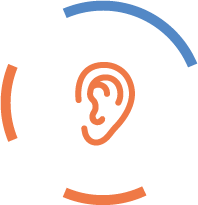Here we provide policymakers and commissioners with a quick overview of the ear, hearing, hearing loss and hearing care in the UK.
Watch this video for a quick recap of the anatomy of the ear.
This video is by Armando Hasudungan[1].
Hearing is the ability to detect sounds in everyday life and listening is the ability to interpret them - e.g. follow conversations in a noisy environment.
Loudness- with quieter sounds or pitch, or both
- in a quiet or noisy environment, or both
Hearing loss can be
- unilateral or bilateral
- temporary or permanent, and
- stable or progressive.
- Sensorineural hearing loss accounts for more than 90% of all hearing loss in adults. In most cases it is permanent and there is no medical or surgical treatment [2]. Age-related hearing loss is the main cause of sensorineural hearing loss [3].
- Conductive hearing loss accounts for 8% of hearing loss in adults. There is often a mechanical cause - e.g. impacted wax, perforated eardrum [4]. It is usually temporary but can be permanent. There are medical and surgical treatments for certain forms of conductive hearing loss.
People that have a sensorineural and conductive hearing loss are said to have mixed hearing loss. Read more about the causes of hearing loss.
The ears first become less sensitive to higher pitched sounds – e.g. children and female voices. This can make conversations difficult to follow and communication more difficult. This can have a negative impact on quality of life but is often missed because people think about hearing loss in terms of “loudness” and not “pitch.” This early stage of age-related hearing loss might wrongly be perceived as “slowing down with age”.
The ears then become less sensitive to quieter sounds, and people might turn-up the volume on the TV. This is the more stereotypical and identifiable sign of hearing loss – i.e. not hearing quieter sounds. However, at this stage people are likely to have difficulty with both loudness and pitch.
Unsupported hearing loss can increase the risk of social isolation, loneliness, depression and reduce quality of life. Read more about the impact of hearing loss.
It is therefore important that reported hearing difficulties are assessed and not dismissed just because a person can hear a doctor (GP) in quiet room for example.
In the vast majority of cases a hearing care professional can examine and manage people with hearing loss without the need for a medical opinion from a GP or ENT. A typical ear and hearing examination will include:
- History and symptoms, including an assessment of communication needs
- Otoscopy - examination of ear health
- Audiometry
- Tympanometry where clinically indicated.
An audiologist needs to record history and symptoms, perform audiometry and other tests before it is possible to understand an individual's hearing ability and address their communication needs.
Audiometry tests hearing acuity. It measures sensitivity to pitch and loudness under specified conditions. The test produces an audiogram. The audiogram compares an individual's hearing sensitivity to a reference standard of 'average hearing'. It can also help establish whether somebody has sensorineural, conductive or mixed hearing loss. The audiogram does not define whether an individual will benefit from a specific intervention.
The audiologist can also assess the ear using other tests - e.g. tympanometry and otoscopy - to help confirm the type and cause of hearing loss and decide whether a referral to a medical colleague is required.
Updates
Originally published: 2016
Reviewed: September 2020
Next review date: September 2021
Info: The original resource was updated as part of the NCHA website upgrade in 2020.
References and notes
[1] Armando Hasudungan, anatomy, ear overview. Permission granted via email 10 September 2020 , https://armandoh.org/
[2] Yueh, B. et al. 2003. Screening and Management of Adult Hearing Loss in Primary Care: Scientific Review. JAMA: Journal of the American Medical Association, 289(15), pp. 1976-1985.
[3] Zahnert T. The Differential Diagnosis of Hearing Loss. Deutsches Ärzteblatt International. 2011;108(25):433-444. doi:10.3238/arztebl.2011.0433;
Yueh, B. et al. 2003. Screening and Management of Adult Hearing Loss in Primary Care: Scientific Review. JAMA: Journal of the American Medical Association, 289(15), pp. 1976-1985.
[4] Zahnert T. The Differential Diagnosis of Hearing Loss. Deutsches Ärzteblatt International. 2011;108(25):433-444. doi:10.3238/arztebl.2011.0433.

 Your hearing and aural health
Your hearing and aural health  Commissioners and Policymakers
Commissioners and Policymakers  Member support and guidance
Member support and guidance News and views
News and views
 Hearing map
Hearing map
